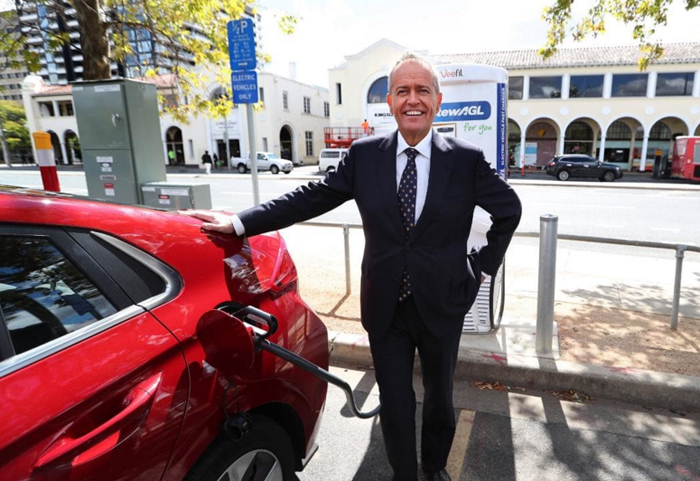Electrifying transport, boosting renewables and tightening pollution controls are the linchpins of Labor’s climate plan

For all the chatter about surpluses, the budget was only the second most important economic event last week. First by a country mile was Bill Shorten’s launch of Labor’s 30-year blueprint for zero net carbon emissions by 2050.
All elections are important, but the federal election in May is shaping up as something exceptional – one of those epochal events that happen maybe three or four times in a lifetime. And it’s a fair bet that within a couple of months Labor will be in government.
One of the many things electors failed to grasp about climate change in 2007 when they opted for Kevin Rudd over John Howard was the huge scale of effort required to wean our economy off its reliance on fossil fuels.
Economist Ross Garnaut, reviewing policy options for Labor, advised we would have to cut emissions by 90 per cent by 2050, for which we would need an economy-wide price on carbon pollution that covered petrol and diesel for transport as well as fossil-fuelled electricity.
Rudd, who famously declared climate change to be our greatest moral challenge, baulked at cutting transport emissions and rejected the 90 per cent target as over-ambitious, opting instead for 60 per cent below 2005 levels. He didn’t want to scare electors.
While Garnaut and Australian scientists argued for a huge national effort with the burden spread across the whole economy, our political establishment decided they knew better. Australians went along with them because Garnaut seemed to be applying a sledgehammer to a peanut.
Times have changed. Several fiery summers and extreme flood events later, we get it.
Bill Shorten’s plan is to cut emissions by 45 per cent below 2005 levels by 2030 and eliminate them by 2050. Australia has barely started that task, which is why Labor’s scheme is both economically important and far more demanding than Garnaut’s “over-ambitious” target was all those years ago.
The three linchpins to Labor’s plan are electrifying transport, giving a huge boost to renewable energy, and tightening the Coalition’s pollution cap mechanism to take in more companies.
Producing nearly 20 per cent of Australia’s emissions, cars, buses and trucks are one of the fastest growing sources of pollution, but no government has yet found the courage to take the steps necessary to radically transform a whole population’s driving habits.
If Labor wins the May election it will introduce Australia’s first national electric vehicle program, aiming to have electric cars making up half of all new cars sold by 2030, while also imposing emissions standards for petrol and diesel vehicles.
Labor will support rollout of new stations for recharging electric vehicles – a very busy space right now with almost-weekly innovations in charging and battery technologies. The ultimate aim is today’s level of convenience in refuelling petrol and diesel vehicles.
By Australian standards (if not by European ones), the Shorten plan to achieve 50 per cent renewable electricity by 2030 is massively ambitious. Labor claims the scheme will bring more than 70,000 new jobs to more than make up for those lost in the coal economy.
Solar households will be attracted to Labor’s offer of $2000 rebates for battery storage units. The aim is a million units by 2025, to retain unused solar energy and boost availability of dispatchable power when other sources fail.
Ultra-conservatives won’t like Labor’s extension of the pollution cap, or “safeguard mechanism”, introduced under Malcolm Turnbull. But it has enough in common with Turnbull’s “National Energy Guarantee” to be called bipartisan – crucial if strong climate mitigation policy is to endure.
The plan would see the 250-odd biggest industrial polluters forced to meet much tougher pollution baselines, but Labor is allowing businesses to buy international offsets and to make money from credits earned if they get below their baselines. That’s emissions trading, in everything but name.
One thing missing from the Labor plan is solid, meaningful recognition of the crucial role of youth in achieving a safe climate. Young people know this is all about their lives to come. They are angry at government dithering, and now are starting to take matters into their own hands.
Our nation’s children are passionate about climate. They were first to react to Greta Thunberg’s brave one-person protest against Swedish government inaction with a school strike in November, in Tasmania and other states. That triggered last month’s global eruption of mass school protests.
Young Australians want an innovative government, in a social and economic sense as well as a technological one. They also want Australia to have a higher profile globally.
Shorten’s pledge to reinstate a climate ambassador, reengage in the formal international process and support Pacific neighbours is a good start, but we need much more. As the developed nation with most to lose from climate change, it’s time we lifted our game on the world stage.
